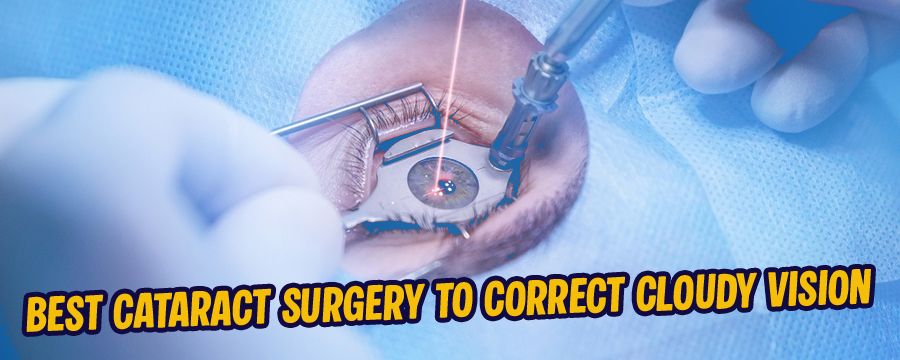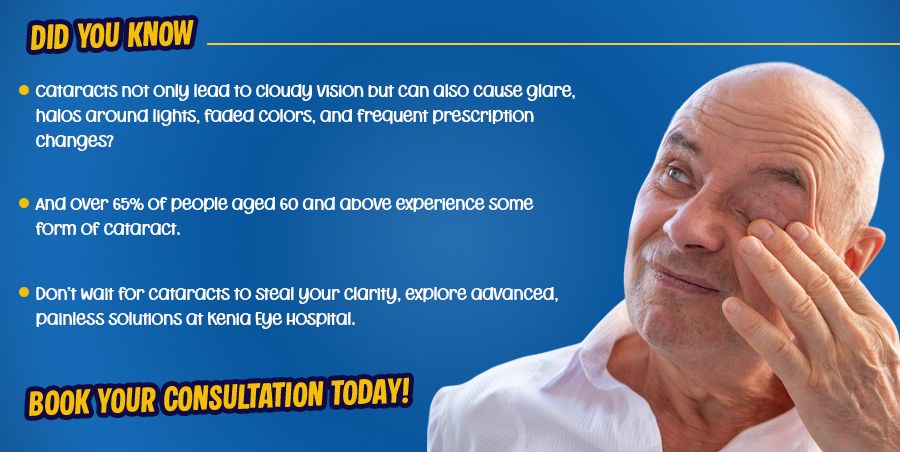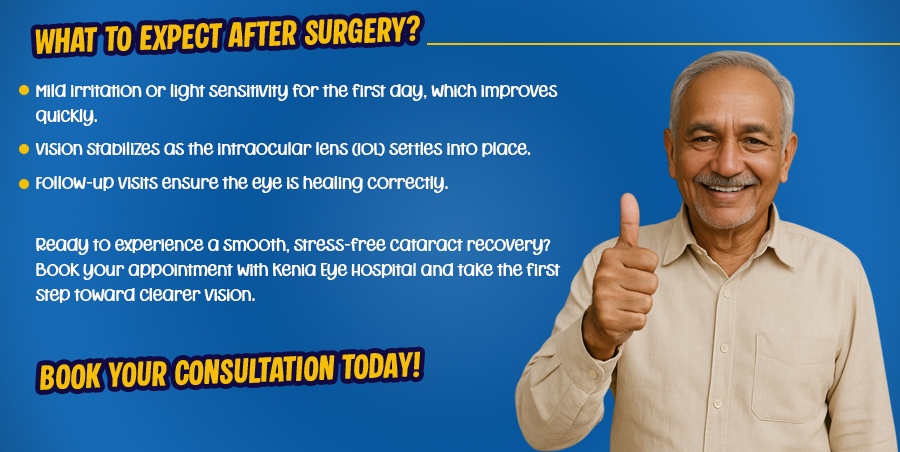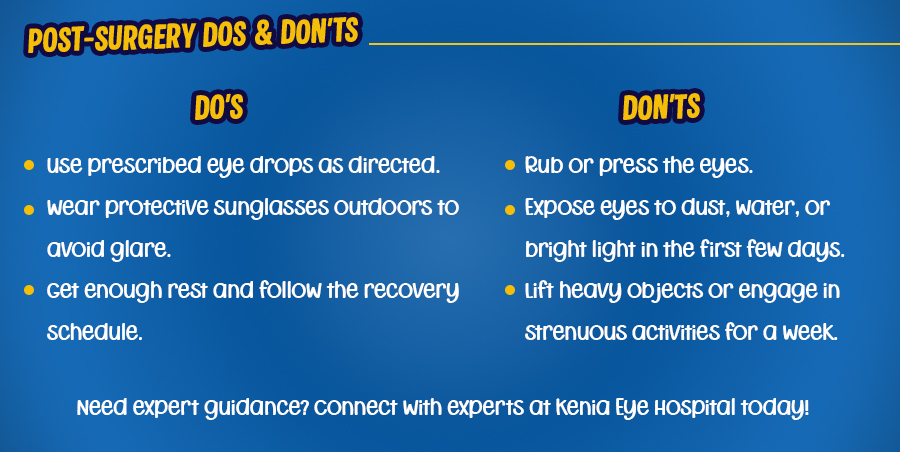Best Cataract Surgery To Correct Cloudy Vision

Cloudy vision making everyday tasks difficult? Cataracts are often the culprit behind this blurred or foggy eyesight. The good news is that the Best Cataract Surgery options, such as advanced femtosecond laser and micro-incision techniques, can restore crystal-clear vision in just in 10 minutes while being painless, bladeless, and fast. Unlike temporary vision issues, cataracts cannot be reversed with glasses or medication. This advanced treatment not only clears vision but can also correct refractive errors like astigmatism or presbyopia, giving you the freedom to see without glasses.
At Kenia Eye Hospital, a leading cataract eye hospital in Mumbai, we offer advanced solutions such as laser cataract surgery and premium lens implants designed for quick recovery and lasting clarity. With over 100,000 successful surgeries and 25+ years of expertise, we are known for delivering the best cataract treatment in Mumbai with advanced technology and expert care.
Keep reading to find out the latest cataract surgery techniques and their benefits.

Types of Cataract Surgery and Lens Options
Modern cataract treatment has evolved from traditional methods to highly advanced, bladeless cataract surgery that offers precision, safety, and quicker recovery. Choosing the Best Cataract Surgery depends on your cataract stage, eye health, and preferred lens type. At Kenia Eye Hospital, a trusted cataract eye hospital in Mumbai, we offer the following advanced options:
Advanced Cataract Surgery Techniques:
1. Phacoemulsification (Phaco) Surgery
Phacoemulsification is the most common modern cataract surgery technique. It uses ultrasound energy to emulsify (break up) the cloudy lens (cataract), which is then suctioned out. An intraocular lens (IOL) is implanted in its place..
Benefits
- Minimally invasive: Requires only a small incision (2.2-2.8 mm).
- Fast recovery: Less trauma means quicker healing.
- High success rate: Widely used with excellent outcomes.
- Outpatient procedure: Typically takes 15–20 minutes.
- Wide availability: Most surgeons are trained in this technique.
2. Micro-Incision Cataract Surgery (MICS) Full Stop Surgery
MICS is an evolution of traditional phacoemulsification that uses ultra-small incisions (usually <2.0 mm). It uses advanced phaco machines and fluidics systems to maintain stability and efficiency through a smaller wound.
Benefits:
- Smaller incisions reduce surgical trauma and speed healing
- Faster recovery and less astigmatism
- Lower risk of infection and inflammation
- Better wound sealing and less need for sutures
- Ideal for patients with coexisting corneal conditions or dry eyes
3. Evolution Cataract Surgery
Cold phaco is a refinement of traditional phacoemulsification. Cold phaco refers to a technique that minimizes heat generation during phacoemulsification by using lower ultrasound energy, improved cooling systems, and efficient fluidics.
Benefits:
- Reduced risk of thermal burns at the corneal incision
- Protects corneal endothelial cells
- Less inflammation and edema
- Safer in dense cataracts and compromised corneas
- Enhanced safety for patients with previous corneal surgeries
4. Femtocataract Surgery (Femtosecond Laser-Assisted Cataract Surgery – FLACS)
Benefits
- Greater precision: Especially useful for complex cases.
- Less ultrasound energy needed: Due to pre-fragmentation of the lens.
- Better lens positioning: Aids in the accurate placement of premium IOLs.
- Improved outcomes with premium lenses: Especially multifocal or toric IOLs.
- Reduced surgical variability: Laser automation minimizes manual errors.
Premium Intraocular Lens (IOL) Options:
Cataract surgery is also about enhancing visual quality. At Kenia, we offer a variety of premium IOLs tailored to each patient’s lifestyle and vision needs:
- MONOFOCAL IOL: is the basic type of lens implanted after cataract surgery. It is designed to provide clear distance vision. However, you will need glasses for reading and for close detailed work. That a monofocal lens is available in various materials.
- TORIC MONOFOCAL LENS: It is used to correct corneal astigmatism. Corrects your vision for distance vision and cylindrical power (if any) and will require you to use glasses for near and intermediate work.
- ASPHERIC LENS: Most lenses have a spherical surface, which can induce aberrations in vision. Aspheric optics ensure better quality vision and enhanced contrast sensitivity. It also allows better night vision and visibility under low light condition.
- MULTIFOCAL LENS: It is designed to help to see clearly at near, intermediate, and far distance, and reduces the dependency on glasses. This does not mean that you can do away with glasses completely and may occasionally need glasses for very fine tasks at near and distance.
- MULTIFOCAL TORIC LENS: Corrects cataract and astigmatism, provides clear vision for near, intermediate, and far distance, and reduces the dependency on glasses. This does not mean that you can do away with glasses completely and may occasionally need glasses for some fine tasks at near and distance
- EDOF: have become popular because patients are provided with high-quality, visual comfort without the annoying side-affects like halos and glare that are seen often with multifocal lenses. It serves all the visual needs of the patients and unlike multifocal lenses, it does not have night-time problems of halos and glare
The choice of IOL depends on your lifestyle, vision goals, and eye condition. For example, active individuals who want freedom from glasses may prefer multifocal or premium IOLs, while those focused on clarity for distance may find monofocal IOLs ideal.

Unmatched Expertise and Technology at Kenia Eye Hospital: Redefining Cataract Care
At Kenia Eye Hospital, we focus on delivering personalized, high-definition vision correction. Instead of a one-size-fits-all approach, our team evaluates every patient’s unique eye condition, lifestyle requirements and future vision goals to determine the Best Cataract Surgery option. Here is what sets us apart:
- Next-Gen Technology, Not Just Tools: With the Ziemer Z8 NEO femtosecond laser, we bring bladeless cataract surgery to a level of precision and customization that few hospitals in Western India offer.
- Customized Lens Goals: Whether you want sharper night vision or freedom from glasses, we select premium IOLs tailored to your lifestyle needs.
- Seamless Recovery Experience: Patients often resume normal activities within a day or two, thanks to micro-incision cataract surgery (MICS) that speeds up healing while minimising discomfort.
- Proven Track Record: With 100,000+ successful cataract surgeries and 25 years of expertise, we are trusted as a leading cataract eye hospital in Mumbai.

Conclusion
Your vision defines how you experience the world, from the colours you see to the confidence you feel every day. Modern cataract treatments aren’t just about clearing cloudy vision; they are about upgrading your eyesight with advanced lenses and precision technology that let you live life to the fullest. If you have been endlessly searching for cataract surgery near me, know that the femtosecond laser-assisted cataract surgery, combined with premium IOLs, is widely considered the best cataract surgery to correct cloudy vision due to its accuracy, safety, and quick recovery.
At Kenia Eye Hospital we bring together 25+ years of expertise, bladeless laser technology, and personalized care to help you see the world more vividly than ever. Book your cataract consultation today and take the first step toward crystal-clear vision!
FAQ’s
1. Can I delay cataract surgery until it's severe?
Many people think cataract surgery should be delayed until vision is almost gone, but early surgery is often recommended when cataracts start interfering with daily tasks like reading, driving, or working.
2. Are cataracts reversible without surgery?
No. While some lifestyle changes may slow their progression, surgery is the only permanent and effective way to restore clear vision.
3. Is cataract surgery painful?
Cataract surgery is generally painless. Eye drops are used to numb the eye, and most patients only feel mild pressure during the 10-15 minute procedure.
4. Can both eyes be treated at the same time?
Usually, no. Surgeons prefer to operate on one eye at a time, with a minimum gap of 1-2 days between surgeries, to ensure optimal results and healing.
5. What is Posterior Capsule Opacification (PCO)?
PCO, often called an "after-cataract," is a cloudiness that can appear behind the implanted lens after cataract surgery. It can be easily corrected with a quick, painless laser procedure.